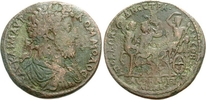
Tmolos (AD 128-137) AE 19 - Sabina375 viewsSabina, Augusta, 128-136/7 AD. AE19 (4.46g, 7h). Draped bust right, wearing stephane / Apollo standing right, holding bow and arrow. Near VF, green patina. Fine style portrait. Rare.
For a general introduction to the city of Tmolus and its coinage see Clive Foss, “A neighbor of Sardis: the city of Tmolus and its successors,†Classical Antiquity, vol. 1, no. 2 (Oct. 1982), pp. 178-201. While some of the city’s pseudo-autonomous issues are problematic to date, it appears that Tmolus first gained the right to coin in her name under Hadrian (Foss p. 180). Coinage with imperial portraits from his reign appears in three denominations: the current issue in the name of Sabina being the smallest denomination, the rare type of Antinous serving as a double (Blum p. 51, 1), and a type in the name of Hadrian and Aelius (Triton XV, lot 1393), which has only recently come to light, valued at one and a half times the current type. Tmolus issued coinage very sporadically and it is doubtful that a mint was established for such a small output, with nearby Sardis being a logical point of production.
|
|

Tmolos (AD 136-138) AE 30 - Hadrian & Aelius744 viewsHadrian, with Aelius Caesar, 136-138 AD. AE30 (16.46g, 1h). AV • AΔPIANOC • CЄ • Λ • AI • KAI-CAP, confronted busts of Hadrian right, laureate and draped, and Aelius left, bareheaded and cuirassed, with slight drapery / TMOΛI-TΩN, Tmolus standing facing, head right, leaning on knotted staff and cradling the infant Dionysus in a fawn skin (nebris) tied around his neck. EF, dark brown patina, lightly rubbed on high points.
|
|

Tmolos-Aureliopolis (AD 177-192) AE 38 - Commodus577 viewsCommodus, 177-192 AD. AE38 (29.53g, 12h). Laureate, draped, and cuirassed bust right / Dionysus holding scepter in chariot drawn left by biga of centaurs. Fine, brown and green rough surfaces, minor deposits. Very rare. Ex. Wagner Coll.
According to Euripides (Bacchae 461-464), Mount Tmolus was the birthplace of the god Dionysus. The son of Zeus and Semele (a princess of Thebes), Dionysus was a god of fertility, vegetation and wine. He is often depicted being transported in a car drawn either by panthers, or (as in this case) by centaurs, surrounded by an entourage of satyrs, sileni, maenads, and nymphs. A number of important festivals were held in his honor; most famous were the Lesser or Rural Dionysia (in late December), the Greater or City Dionysia (in late spring), the Anthesteria (in early spring), and the Lenaea (in winter). His characteristic worship was ecstatic, and women, known as maenads, were prominently involved. Votaries, through music, dancing, and drinking, and through eating flesh and blood of sacrificial animals, attempted to merge their identities with the wildness of nature.
|
|

Tmolos-Aureliopolis (AD 198-217) AE 34 - Caracalla265 viewsCaracalla, 198-217 AD. AE34 - Medallion (24.84g). Laureate, draped and cuirassed bust right / Apparently unique and unpublished. Dark brown patina. VF. Ex Gorny & Mosch sale 90 (1998), lot 615.
|
|

Tmolus (AD 138-141) AE 15 - Faustina I199 viewsFaustina I, Augusta, 138-140/1 AD. AE15 (3.82g). ΦAVCTЄINA CЄBACTH, draped bust right / TMΩΛITΩN, Artemis advancing right, holding bow and drawing arrow from quiver; to left, hound advancing right. Extremely rare. aVF. Plankenhorn coll.
|
|

Tmolus-Aureliopolis (AD 177-192) AE 33 - Commodus449 viewsCommodus, 177-192 AD. AE33 (23.20g). Laureate, draped and cuirassed bust right, seen from behind / AΠOΛΛΩNI-ΔHXXTP ANΕΘ AΥΡΗ/ΛIOΠOΛEI, Apollo standing right in biga drawn by two griffins. Fine, brown patina.
|
|
|
|
